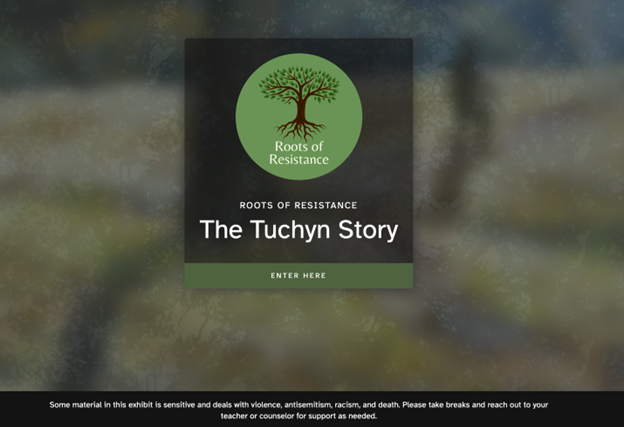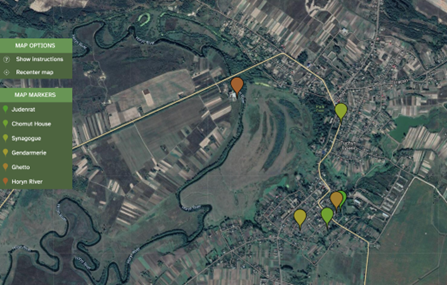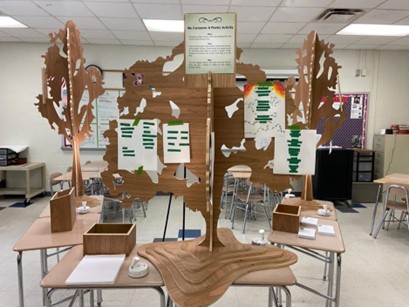Commemorating the Jews of Tuchyn: A Holocaust history exhibit
23 August 2022 – Saskia Lascarez Casanova
Roots of Resistance: The Tuchyn Story is a hybrid exhibition about a Jewish uprising in the Tuchyn Ghetto against Nazi occupiers in Tuchyn, Ukraine, during World War II. When nearby refugees arrived in Tuchyn, they warned Jews of the dangers coming towards the town. By arming themselves, the Jewish people of the town executed a plan to resist by setting their homes and synagogue on fire and escaping into the nearby forest. Out of 2,600 who escaped from the Tuchyn Ghetto, only 69 survived.
The exhibition originated from the personal family history of Dr. Anne E. Parsons, director of public history at the University of North Carolina at Greensboro. Parsons discovered that some relatives had migrated to the United States from Tuchyn after World War II. Setting out to unearth her family’s larger history, she created a project for the 2022 MA in History/Museum Studies cohort.

Screenshot of the digital exhibition landing page with trauma-informed care content warning.
Partnering with the North Carolina Council on the Holocaust and the NGO Mnemonics from Ukraine, we began to plan the project. A nationally competitive grant allowed us to hire a web developer and sculptor to create the digital and physical components of the exhibition. During the Fall 2020 semester, we learned about museum practices and became knowledgeable on best practices for dealing with difficult histories. We analyzed sources such as Hebrew and Yiddish oral history testimonies from the USC Shoah Foundation, Yizkor books (memorial books with testimonies of survivors), along with photographs from archives including Yad Vashem and the U.S. Holocaust Memorial Museum.

Screenshot of the interactive map within the digital exhibition.
After reconvening in Fall 2021, we began curating the digital exhibit. We created an interactive map that explores the town of Tuchyn during the Nazi occupation, a video that depicts the Jewish resistance and uprising, and interviews showing the aftermath from survivors and descendants. We also chose the design of the website, created an interpretive plan for the physical exhibit, and conducted front-end evaluations with local students and educators.

Full exhibition soft launch at a local high school in Raleigh, North Carolina. Photo credit: Anne E. Parsons
Additionally, we consulted with the International Coalition of Sites of Conscience and the North Carolina Academy for Stress, Trauma, and Resilience, which allowed us to include trauma-informed care into our approach. We wanted to ensure this work made students feel safe to learn and explore the history of Tuchyn, with a content warning at the beginning and participatory elements that encourage internal reflection.
The final component of the project was the physical exhibit—a group of trees with prompts that allow users to ground themselves in the space and reflect on the importance of being upstanders. This exhibition will travel around high schools in North Carolina over the next decade, and the digital exhibit is available for anyone to enjoy. Our hope is that we can teach the public about the importance of compassion toward others and inspire them to fight against injustices in their community.
~Saskia Lascarez Casanova earned an MA in History/Museum Studies from the University of North Carolina at Greensboro. She is interested in the intersections of social justice activism and difficult histories, as well as cultural traditions and the American Latino in the southern U.S.




Am always interested in tuchyn and surrounding area since it’s a good possibility I have ancestors from there
My grandmother and father were 2 of the 69 who survived.
My great-grandparents had already left Tuchyn in the early 1900’s but all of their siblings who stayed perished. Is there any online documentation where I could search for their name (“Dimmerman”)? Is any of the exhibit available online still?
I wonder if they had owned property there, what happened to it? Was it taken over by the Soviet State since there was no “private” property under Communism? Did Ukrainians just take it over as it was ‘abandoned’??